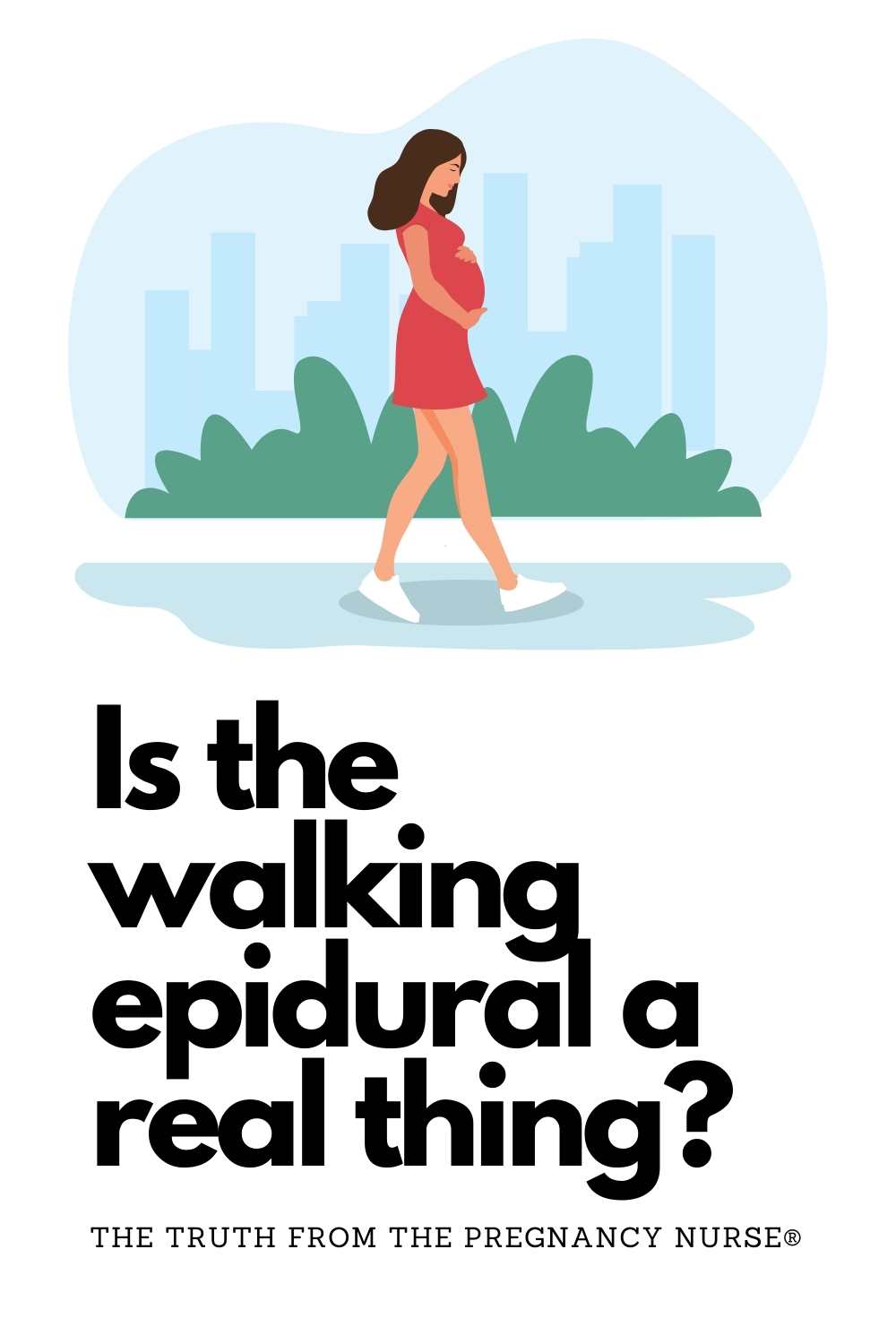👋 I’m so glad YOU are here. Are you looking to also get your partner prepared? This is for BOTH of you. Couples just love it and I know you want to both feel prepared!
Are you wondering if you can get a “walking epidural” — the answer is that it DEPENDS. Some hospitals still do them, but I can give you some tips to still allow movement but also have your pain controlled. The idea is to allow a lot of movement, while also taking away a lot of pain. So, how can that happen?

But first off, why do I know so much about Epidurals? Hi, I’m Hilary — The Pregnancy Nurse® — I’ve been a nurse since 1997 and I have 20 years of labor and delivery experience. I helped with thousands of epidurals, in addition to having a few of my own — so I’m a great resource on a topic that can be hard to understand.
This is part of my Complete Guide to Epidurals — so if you have more questions don’t miss that!
How Does a Walking Epidural Work?
The idea is that you have a small dose of medication that will take away a good amount of the pain (especially early in labor) but also allow you to move. Now, that doesn’t always mean that you can WALK — it means that you can MOVE (aka, move in bed or possibly sit at the bedside).
More often when you get into real active labor (usually around 6 cm) people want MORE pain relief and the epidural amount (and possibly the type of med) is increased at that point. They are no longer able to walk at that point.
And yes, I go into how the epidural is placed, and what to expect from it in here. It really makes it easy to understand!

Can you really WALK with a “Walking Epidural”?
It seems for the majority of places that offer this, the answer is no.
Some places to allow you to try to get up to the restroom (although a lot of people can’t pee when they get there). Some allow you to sit upright or even be on the birthing ball.
But, many are just allowing patients to move more in bed, perhaps be on all 4’s a bit more comfortably and move themselves better (not having to ask a team of nurses to move them). That type of autonomy feels really great for patients, and I love that part.
It’s hard when, as a nurse, you’re busy and can’t go turn a patient, even when you know that will help their labor progress. If patients can turn themselves that’s a big win for them.
Do all hospitals offer a walking epidural?
No, in fact most do not. In polling L&D nurses around the world I noted that a lot of hospitals in Canada offer them, and often older anesthesiologists offer them, but younger ones do not.
Why would they not offer them?
I would guess because they do not offer good pain relief overall. It really takes the edge off of the pain and I guess the question is if that’s worth the “risk” of having the epidural catheter inserted. Remember we’re always weighing risks and benefits.
They may also get frustrated that it’s not actually providing pain relief like people want (especially in the US where the expectation/hope is a pain-free birth) and then have to come tinker with it consistently.
And, the reality is that our doctors really can only learn what’s taught to them. So, if they aren’t learning it in residency they don’t practice that way. — And THAT my friend, is the real reason (also the reason, for the most part) that doctors want to deliver you on your back and don’t do breech deliveries.
And if you’re wanting to know more about your pain management options grab this:
How does the epidural work?
I think in order to understand how a WALKING epidural works, we first need to talk about how an epidural works in general.
So, they find the epidural space, and then insert a tube into that space (after making sure it’s not in a blood vessel). That tube pumps in medicine, usually a narcotic (often Fentanyl) and a -caine (usually bupivacaine — that’s similar to NOVAcaine that they use in your mouth when you go to the dentist). That offers the pain relief but also numbing.
With a walking epidural, I hear that they often use the narcotic, but not the numbing stuff. That allows your legs to still be able to help you stand and take the pressure of your body.
How you can the benefits of a “Walking Epidural” even if they don’t offer them?
First off, unless your hospital specifically says they will allow to walk with an epidural you need to get that idea out of your mind. Most people aren’t going to be able to walk safely with an epidural in.
Also, if you are able to walk there is a very good chance the epidural isn’t working very well (aka taking away a lot of pain) due to how it works. That’s just something to keep in mind.
But, what you can ask for is a low dose. Your epidural will be hooked-up to a pump where we send in medication to the epidural space to take care of the pain. That is usually hooked-up at a certain rate which we can both increase and lower.
There’s a lot of ways you can use this.
Do you need a nap and then want to move more — ask for more at the beginning and then ask them to lower it to a spot that is bearable for you.
They most often also give you a “button” you can push if the pain is too much. However, it’s not great to just keep using the button — if you’re using it often, I would increase that rate to take care of the pain rather than having “up’s” and “down’s” constantly.
Unfortunately that isn’t really how we run them. Some hospitals require that anesthesia up or lower the dose (which means they really don’t want to mess with it). You can always ask for an order to have it in a certain range and your nurse can change it if that’s possible?
Hilary’s Experience: Many anesthesiologists (but certainly not all) don’t want to do a thing once an epidural is placed. Even though they are paid to manage it throughout the rest of the time it is on (and not a small amount). Get what YOU want from that epidural — even if it means they need to come in and help.
So, if your epidural is too heavy and you’d prefer it’s not, then ask them to turn it down. That’s my best tip for you in this article.
Learning about your options (because MOST anesthesiologists will NOT tell you about that option) is a real win. Come join me in The Online Prenatal Class for Couples where we talk about your options and how to talk with your birth team to make the best choices for yourself and your birth!
Looking to get prepare for your birth? I have some easy options for you!
~~~~~~~~
– Worried you’re missing something? Grab my pregnancy planner so you don’t miss a thing!
– Thinking about an induction? Grab Inductions Made Easy to feel prepared in just 20 minutes!
– Wondering how to get that baby OUT? Grab Going Into Labor Made Easy so you know how to (and not to) do it!
– Postpartum got you anxious? Check out Postpartum Care Made Easy so you can stay SAFE even when all your attention is on that little on.
🚨 AND if ALL OF IT has got you on edge The Online Prenatal Class for Couples is perfect for you — You’ll feel so ready before you even know it!
~~~~~~~~
No matter WHERE you are at in your pregnancy journey, we have resources that can help!
And, if you’re not quite sure you’re ready for that whole thing, check out my free prenatal class. It’s your first step toward getting in the driver’s seat of your birth.







 Can Curb Walking Induce Labor?
Can Curb Walking Induce Labor?
